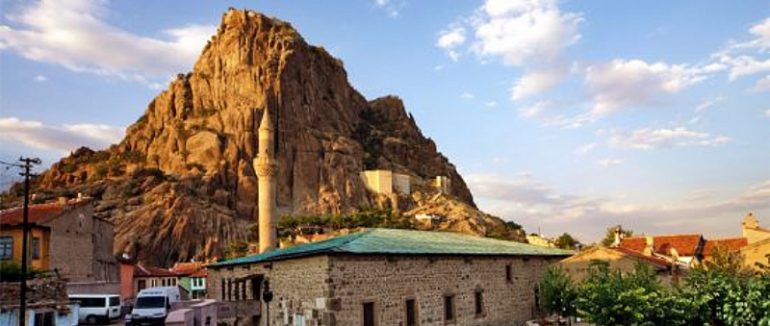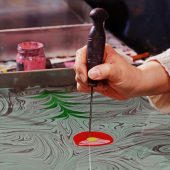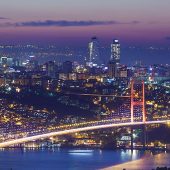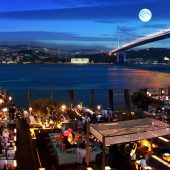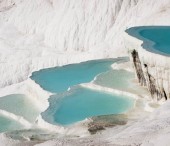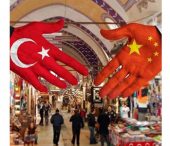Afyonkarahisar is a city in western Turkey, the capital of Afyon Province. Afyon is in mountainous countryside inland from the Aegean coast, 250 km (155 mi) south-west of Ankara along the Akar River. Elevation 1,034 meters. Population (2000 census) 128,516.
Being high up the weather in winter is cold and the roads are icy.
Etymology
The name is Turkish for the black castle opium, since opium was widely grown here and there is a castle on a black rock. Also known simply as Afyon. Older spellings include Karahisar-i Sahip Afium-Kara-hissar and Afyon Karahisar.City was known as Afyon (opium), until the name was changed to Afyonkarahisar by Turkish Parliament in 2004.
History
The top of the rock in Afyon has been fortified for a long, long time. It was known to the Hittites as Hapanuwa, and was later occupied by Phrygians, Lydians and Persians until it was conquered by Alexander the Great. After the death of Alexander the city (now known as Akroinon), was ruled by the Seleucids and the kings of Pergamon, then Rome and Byzantium. The Byzantine emperor Leo III after his victory over Arab besiegers in 740 renamed the city Nicopolis (Greek for the Victory City). The Seljuk Turks then arrived in 1071 and changed its name to Kara Hissar (the black castle) after the ancient fortress situated upon a volcanic rock 201 meters above the town. Following the dispersal of the Seljuks the town was occupied by the Sahipoğulları and then the Germiyan.
The castle was much fought over during the Crusades and was finally conquered by the Ottoman Sultan Beyazid I in 1392 but was lost after the invasion of Timur Lenk in 1402. It was recaptured in 1428 or 1429.
The area thrived during the Ottoman Empire, as the centre of opium production and Afyon became a wealthy city with the typical Ottoman urban mixture of Jews, Armenians, Greeks and Turks. This ended when during the Greco-Turkish War (1919-1922) campaign (part of the Turkish War of Independence) Afyon and the surrounding hills were occupied by French, Italian and then Greek forces. However, it was recovered in August 27, 1922, a key moment in the great Turkish counter-attack in the Aegean region. After 1923 Afyon became a part of the Republic of Turkey.
The region was a major producer of opium (hence the name Afyon) until the late 1960s when under international pressure, from the USA in particular, the fields were burnt and production ceased.
Afyon today
Afyon is the centre of an agricultural area and the city has a country town feel to it. There is little in the way of bars, cafes, live music or other cultural amenities, and the standards of education are low for a city in the west of Turkey. However Afyon Kocatepe University opened in the 1990s and this must surely lead to improvements eventually. Nowadays Afyon is known for its marble (in 2005 there were 355 marble quarries in the province of Afyon producing high quality white stone), its sucuk (peculiar sausages), its kaymak (meaning either cream or a white Turkish Delight) and various handmade weavings. There is also a large cement factory.
This is a natural crossroads, the routes from Ankara to İzmir and from Istanbul to Antalya intersect here and Afyon is a popular stopping-place on these journeys. There are a number of well-established roadside restaurants for travellers to breakfast on the local cuisine. Some of these places are modern well-equipped hotels and spas; the mineral waters of Afyon are renowned for their healing qualities. There is also a long string of roadside kiosks selling the local Turkish delight. Afyon is also an important railroad junction between İzmir, Konya, Ankara and Istanbul.
The cuisine of Afyon
Main courses....
sucuk - the famed local speciality, a spicy beef sauasage, eaten fried or grilled. The best known brands include Cumhuriyet.
etli pide - a kind of minced beef pizza.
ağzı açık or bükme - filo-style pastry stuffed with cheese or lentils.
keşkek - boiled wheat and chick peas stewed with meat.
and sweets....
local cream kaymak eaten with honey, with a bread pudding ekmek kadayif, or with pumpkin simmered in syrup. Best eaten at the famous Ikbal restaurants (either the old one in the town centre or the big place on the main road).
Turkish delight.
helva - sweetened ground sesame
Places of interest
The partly ruined fortress which has given the city its name
Ulu Camii (the Great Mosque)
Altigöz Bridge, like the Ulu Camii built by the Seljuks in the 13th century.
the White Elephant - Afyon is twinned with the town of Hamm in Germany, and now has a large statue of Hamm's symbolic white elephant.
With its rich architectural heritage, the city is a member of the European Association of Historic Towns and Regions

